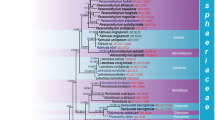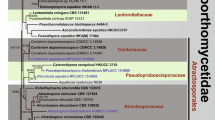Abstract
The phylogenetic relationship of Jattaea and Wegelina, two morphologically related genera of the Calosphaeriales, is analyzed in two molecular analyses using the Internal transcribed spacer region of the DNA operon, and the nuclear large and small subunits of ribosomal DNA combined with the second largest subunit of RNA polymerase for a multigene analysis. For each data set maximum likelihood, maximum parsimony and Bayesian analyses were performed. Type and herbarium material of two lectotype species Jattaea algeriensis and Wegelina discreta were examined and correlated with results from in vitro studies. The phylogenetic analyses show that both species are congeneric. The name Jattaea is accepted to include species with hyaline, allantoid to suballantoid ascospores in clavate, stipitate asci without apical annulus borne on individual cells on ascogenous hyphae and with phialophora-like anamorphs produced in axenic culture. Twelve species are accepted in Jattaea, the concept of the genus is outlined and a key to its species is provided. The genus Wegelina is reduced to its synonymy. Molecular data also show that septation of ascospores, a diagnostic feature used to separate calosphaeria-like fungi into the genus Phragmocalosphaeria, does not appear to be relevant in distinguishing genera in the Calosphaeriales. Therefore, Jattaea includes species with both one-celled and septate ascospores and Phragmocalosphaeria is accepted as its generic synonym. The genus Jattaea and its phialophora-like anamorphs is compared with other genera of the Calosphaeriales and the phylogenetically related Togniniaceae. The revision of four species of Ceratostomella, i.e., C. echinella, C. leptorrhyncha, C. mali and C. microspora, revealed their striking morphological similarities with the Calosphaeriaceae and the Togniniaceae. These are identified as species of Jattaea, Togninia and Togniniella and the respective new combinations are proposed.
















Similar content being viewed by others
References
Barr ME (1983) The ascomycete connection. Mycologia 75:1–13
Barr ME (1985) Notes on the Calosphaeriales. Mycologia 77:549–565
Barr ME (1998) Wegelina a reinstated genus in the Calosphaeriales. Cryptogram Bryol Lichénol 19:169–173
Barr ME, Rogers JD, Ju MJ (1993) Revisionary studies in the Calosphaeriales. Mycotaxon 48:529–535
Berlese AN (1900) Icones Fungorum omnium hucusque cognitorum, vol 3. Padova
Cash EK (1952) A record of the fungi named by J. B. Ellis. Division of Mycology and Disease Survey, Bureau of Plant Industry, Soils, and Agricultural Engineering, Agricultural Research Administration, USDA 2:1–165
Clements FE, Shear CL (1931) The genera of fungi. H.W. Wilson Co., New York
Crous PW, Gams W, Wingfield MJ, van Wyk PS (1996) Phaeoacremonium gen. nov., associated with wilt and decline diseases of woody hosts and human infections. Mycologia 88:786–796
Cunningham CW (1997) Can three incongruence tests predict when data should be combined? Mol Phylogenet Evol 14:733–740
Damm U, Crous PW, Fourie PH (2008) A fissitunicate ascus mechanism in the Calosphaeriaceae, and novel species of Jattaea and Calosphaeria on Prunus wood. Persoonia 20:39–52
Dupont J, Laloui W, Magnin S, Larignon P, Roquebert MF (2000) Phaeoacremonium viticola, a new species associated with Esca disease of grapevine in France. Mycologia 92:499–504
Ellis JB, Everhart BM (1892) The North American Pyrenomycetes. Newfield, New Jersey
Gams W, Hoekstra ES, Aptroot A (eds) (1998) CBS course of mycology, 4th edn. Centraalbureau voor Schimmelcultures, Baarn
Gargas A, Taylor JW (1992) Polymerase chain reaction (PCR) primers for amplifying and sequencing nuclear 18S rDNA from lichenized fungi. Mycologia 84:589–592
Groenewald M, Kang JC, Crous PW, Gams W (2001) ITS and beta-tubulin phylogeny of Phaeoacremonium, Phaeomoniella spp. Mycol Res 105:651–657
Gutell RR (1993) Collection of small subunit (16S- and 16S-like) ribosomal RNA structures. Nucleic Acids Res 21:3051–3054
Gutell RR, Gray MW, Schnare MN (1993) A compilation of large subunit (23S and 23S-like) ribosomal RNA structures. Nucleic Acids Res 21:3055–3074
Hall TA (1999) BioEdit 5.0.9: a user-friendly biological sequence alignment editor and analysis program for Windows 95/98/NT. Nucleic Acids Symp Ser 41:95–98
Huelsenbeck JP, Ronquist F (2001) MrBayes: Bayesian inference of phylogenetic trees. Bioinformatics 17:754–755
Kauff F, Lutzoni F (2002) Phylogeny of the Gyalectales and Ostropales (Ascomycota, Fungi): among and within order relationships based on nuclear ribosomal RNA small and large subunits. Mol Phylogenet Evol 25:138–156
Kirk PM, Cannon PF, Minter DW, Stalpers JA (2008) Dictionary of the fungi, 10th edn. CAB International, Wallingford
Kummer V, Richter T, Schwik J (2005) Wegelina grumsiniana comb. nov. (Ascomycetes, Calosphaeriales)-ein Pyrenomycet auf der Porenschicht faulender Zunderschwämme (Fomes fomentarius). Z Mykol 71:227–236
Landvik S (1996) Neolecta, a fruit-body-producing genus of the basal ascomycetes, as shown by SSU and LSU DNA sequences. Mycol Res 100:199–202
Larget B, Simon DL (1999) Markov chain Monte Carlo algorithms for the Bayesian analysis of phylogenetic trees. Mol Biol Evol 16:750–759
Liu YJ, Whelen S, Hall BD (1999) Phylogenetic relationships among ascomycetes: evidence from an RNA polymerase II subunit. Mol Biol Evol 16:1799–1808
Marincowitz S, Crous PW, Groenewald JZ, Wingfield MJ (2008) Microfungi occurring on Proteaceae in the fynbos. CBS Biodiver Ser 7:1–166
Mostert L, Crous PW, Groenewald (Ewald) JZ, Gams W, Summerbell RC (2003) Togninia (Calosphaeriales) is confirmed as teleomorph of Phaeoacremonium by means of morphology, sexual compatibility and DNA phylogeny. Mycologia 95:646–659
Mostert L, Groenewald JZ, Summerbell RC, Robert V, Sutton DA, Padhye AA, Crous PW (2004) Species of Phaeoacremonium associated with human infections and environmental reservoirs in infected woody plants. J Clin Microbiol 43:1752–1767
Mostert L, Groenewald JZ, Summerbell RC, Gams W, Crous PW (2006) Taxonomy and pathology of Togninia (Diaporthales) and its Phaeoacremonium anamorphs. Stud Mycol 54:1–115
Munk A (1957) Danish Pyrenomycetes. A preliminary flora. Dan Bot Arkiv 17(1):1–491
Nixon KC, Carpenter JM (1993) On outgroups. Cladistics 9:413–426
Nylander J (2008) MrModeltest2 v. 2.3. C program for selecting DNA substitution models using PAUP*
Peck CH (1879) Report of the botanist. Ann Rep N Y State Mus Nat Hist 31:19–60
Petrak F (1923) Beiträge zur Pilzflora von Sternberg in Mähren. Ann Mycol 21:107–132
Pirozynski KA, Morgan-Jones G (1968) Notes on microfungi. III. Trans Br Mycol Soc 51:185–206
Réblová M (2006) Molecular systematics of Ceratostomella sensu lato and morphologically similar fungi. Mycologia 98:63–93
Réblová M (2007) Barbatosphaeria gen. et comb. nov., a new genus for Calosphaeria barbirostris. Mycologia 99:723–732
Réblová M, Mostert L (2007) Romellia is congeneric with Togninia and description of Conidiotheca gen. nov. for one species of this genus with polysporous asci. Mycol Res 111:299–307
Réblová M, Štěpánek V (2009) New fungal genera, Tectonidula gen. nov. for Calosphaeria-like fungi with holoblastic-denticulate conidiogenesis and Natantiella gen. nov. for three species segregated from Ceratostomella. Mycol Res 113:991–1002
Réblová M, Winka K (2000) Phylogeny of Chaetosphaeria and its anamorphs based on morphological and molecular data. Mycologia 92:939–954
Réblová M, Mostert L, Gams W, Crous PW (2004) New genera in the Calosphaeriales: Togniniella and its anamorph Phaeocrella, and Calosphaeriophora as anamorph of Calosphaeria. Stud Mycol 50:533–550
Reeb V, Lutzoni F, Roux C (2004) Contribution of RPB2 to multilocus phylogenetic studies of the Pezizomycotina (Euascomycetes, Fungi) with special emphasis on the lichen-forming Acarosporaceae and evolution of polyspory. Mol Phylogenet Evol 32:1036–1060
Rehner S, Samuels GJ (1994) Taxonomy and phylogeny of Gliocladium analysed from nuclear large subunit ribosomal DNA sequences. Mycol Res 98:625–634
Romero AI, Samuels GJ (1991) Studies on xylophilous fungi from Argentina. VI. Ascomycotina on Eucalyptus viminalis (Myrtaceae). Sydowia 43:228–248
Rossman AY, Samuels GJ, Rogerson CT, Lowen R (1999) Genera of Bionectriaceae, Hypocreaceae and Nectriaceae (Hypocreales, Ascomycetes). Stud Mycol 42:1–248
Saccardo PA (1878) Fungi Italici Autographice delineati. Fascs. 9–12, Tabs. 321–480
Saccardo PA (1891) Fungi Italici Autographice Delineati. Fascs. 17–28, Tabs. 641–1120
Saccardo PA (1893a) Fungi novi Europaei et Asiatici. Grevillea 21(99):65–69
Saccardo PA (1893b) Fungi novi Europaei et Asiatici. Grevillea 21(100): Plate 184
Samuels GJ, Candoussau F (1996) Heterogeneity in the Calosphaeriales: a new Calosphaeria with Ramichloridium- and Sporothrix-like synanamorphs. Nova Hedwig 62:47–60
Sawada K (1950) Fungi inhabiting on conifers in the Tohoku district (I). Fungi on Sugi (Cryptomeria japonica D. Don.) (in Japanese). Bull Gov For Exp Stn Tokyo 45:27–53
Schoch CL, Shoemaker RA, Seifert KA, Hambleton S, Spatafora JW, Crous PW (2007) A multigene phylogeny of the Dothideomycetes using four nuclear loci. Mycologia 98(2006):1041–1052
Spatafora JW, Mitchell TG, Vilgalys R (1995) Analysis of genes coding for small-subunit rRNA sequences in studying phylogenetics of dematiaceous fungal pathogens. J Clin Microbiol 33:1322–1326
Spatafora JW, Sung GH, Johnson D, Hesse C, O’Rourke B, Serdani M, Spotts R, Lutzoni F, Hofstetter V, Miadlikowska J, ReebV GC, Fraker E, LumbschT LR, Schmitt I, Hosaka K, Aptroot A, Roux C, Miller AN, Geiser DM, Hafellner J, Hestmark G, Arnold AE, Budel B, RauhutA HD, Untereiner WA, Cole MS, Scheidegger C, Schultz M, Sipman H, Schoch CL (2007) A five-gene phylogeny of Pezizomycotina. Mycologia 98(2006):1018–1028
Stamatakis A, Ludwig T, Meier H (2005) RAxML-III: a fast program for maximum likelihood-based inference of large phylogenetic trees. Bioinformatics 21:456–463
Swofford DL (2002) PAUP*. Phylogenetic Analysis Using Parsimony (*and other methods). Version 4. Sinauer Associates, Sunderland
Traverso JB (1903) Flora italica cryptogama Pars I: fungi Pyrenomycetae. Fascicle 1:1–352
Trouillas FP, Lorber JD, Peduto F, Grant J, Coates WW, Anderson KK, Caprile J, Gubler WD (2010) First report of Calosphaeria pulchella associated with branch dieback of sweet cherry trees in California. Plant Dis 94:1167
Vijaykrishna D, Mostert L, Jeewon R, Gams W, Hyde KD, Crous PW (2004) Pleurostomophora, an anamorph of Pleurostoma (Calosphaeriales), a new anamorph genus morphologically similar to Phialophora. Stud Mycol 50:387–395
Vilgalys R, Hester M (1990) Rapid genetic identification and mapping of enzymatically amplified ribosomal DNA from several Cryptococcus species. J Bacteriol 172:4238–4246
Vilgalys R, Sun BL (1994) Ancient and recent patterns of geographic speciation in the oyster mushroom Pleurotus revealed by phylogenetic analysis of ribosomal DNA sequences. Proc Natl Acad Sci USA 91:4599–4603
von Höhnel F (1905) Mykologische Fragmente LXXVI. Zur Synonymie einiger Pilze. Ann Mycol 3:187–190
White TJ, Bruns T, Lee S, Taylor J (1990) Amplification and direct sequencing of fungal ribosomal RNA genes for phylogenetics. In: Innis MA, Gelfand DH, Sninsky JJ, White TJ (eds) PCR protocols: a guide to methods and applications. Academic, San Diego, pp 315–322
Wuyts J, van de Peer Y, Winkelmans T, de Wachter R (2002) The European database on small subunit ribosomal RNA. Nucleic Acids Res 30:183–185
Zhang N, Castlebury LA, Miller AN, Huhndorf SM, Schoch C, Seifert KA, Rossman AM, Rogers JD, Kohlmeyer J, Volkmann-Kohlmeyer B, Sung GH (2007) An overview of the systematics of the Sordariomycetes based on four-gene phylogeny. Mycologia 98(2006):1077–1088
Acknowledgement
This study was financially supported by the Project of the National Foundation of the Czech Republic (GA206/09/0547) and Institutional Research Concept No. AV0Z60050516 (Institute of Botany of the ASCR). Prof. Walter Gams is thanked for careful reading of the manuscript and providing many suggestions. Drs Paul Kirk and Scott Redhead are thanked for help with solving the nomenclatural problem of Wegelina cryptomeriae and supplying the literature. I am grateful for the help of Dr Václav Štěpánek, who undertook the DNA sequencing of ascospore isolates of Jattaea discreta, other members of the Calosphaeriales and provided other sequences newly presented in this study. The curators of herbaria (B, BP, CBS-H, DAOM, NY, NYS, PAD, PC, PDD, PREM, UPS) are acknowledged for loans of the type and other herbarium material and the curators of the CBS culture collection for supplying reference strains.
Author information
Authors and Affiliations
Corresponding author
Rights and permissions
About this article
Cite this article
Réblová, M. New insights into the systematics and phylogeny of the genus Jattaea and similar fungi of the Calosphaeriales . Fungal Diversity 49, 167–198 (2011). https://doi.org/10.1007/s13225-011-0099-8
Received:
Accepted:
Published:
Issue Date:
DOI: https://doi.org/10.1007/s13225-011-0099-8




